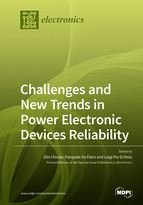Challenges and New Trends in Power Electronic Devices Reliability
A special issue of Electronics (ISSN 2079-9292). This special issue belongs to the section "Power Electronics".
Deadline for manuscript submissions: closed (31 January 2021) | Viewed by 43838
Special Issue Editors
Interests: reliability analysis; Bayesian inference; statistical modeling; power system
Interests: electrical power systems; electric vehicles; optimization models; data analysis; forecasting techniques
Special Issues, Collections and Topics in MDPI journals
Interests: design of high-performance electrical machine; hybrid and full electric propulsion; electrical machine diagnosis and prognostic; energy storage system; reliability analysis of electrical drives
Special Issues, Collections and Topics in MDPI journals
Special Issue Information
Dear Colleagues,
The popularity of electric transportation and the development of smart grid technologies have led the requirement for better performance from power electronic converters and components. In particular, these power electronic devices may operate under high stress, various environmental scenarios, and in overload conditions. Nevertheless, due to their central roles in electrical systems, the necessity to consider the reliability and availability of the devices has become fundamental; this can be assessed both from a technical and economical point of view considering the final scope of the device. Traditional approaches usually consider historical failure data and/or past observed scenarios; however, considering the rapid evolution of the technologies and the high reliability values attained by such components, these data are quite scarce, thus complicating the reliability of our estimations. The goal of this Special Issue is to collect innovative contribution on the reliability assessment of power electronic devices and related components.
The area of interest of this Special Issue includes the following topics:
- Risk analysis of power electronic devices;
- Forecasting system for the reliability of the components;
- Statistical methods for power electronics reliability evaluation (Bayesian inference, statistical modeling, nonparametric approaches, etc.);
- Accelerated testing for the failure rate estimation;
- Dielectric and thermal stress strength models of power electronics devices;
- High reliability power electronics architecture for electric powertrain;
- Risk analysis of battery storage system under critical condition;
- Fault-tolerant control algorithms based on RAMS logic;
- Predictive maintenance for the condition monitoring of power electronic devices;
- Reliability challenges in smart grid installations.
Prof. Dr. Elio Chiodo
Dr. Pasquale De Falco
Dr. Luigi Pio Di Noia
Guest Editors
Manuscript Submission Information
Manuscripts should be submitted online at www.mdpi.com by registering and logging in to this website. Once you are registered, click here to go to the submission form. Manuscripts can be submitted until the deadline. All submissions that pass pre-check are peer-reviewed. Accepted papers will be published continuously in the journal (as soon as accepted) and will be listed together on the special issue website. Research articles, review articles as well as short communications are invited. For planned papers, a title and short abstract (about 100 words) can be sent to the Editorial Office for announcement on this website.
Submitted manuscripts should not have been published previously, nor be under consideration for publication elsewhere (except conference proceedings papers). All manuscripts are thoroughly refereed through a single-blind peer-review process. A guide for authors and other relevant information for submission of manuscripts is available on the Instructions for Authors page. Electronics is an international peer-reviewed open access semimonthly journal published by MDPI.
Please visit the Instructions for Authors page before submitting a manuscript. The Article Processing Charge (APC) for publication in this open access journal is 2400 CHF (Swiss Francs). Submitted papers should be well formatted and use good English. Authors may use MDPI's English editing service prior to publication or during author revisions.








